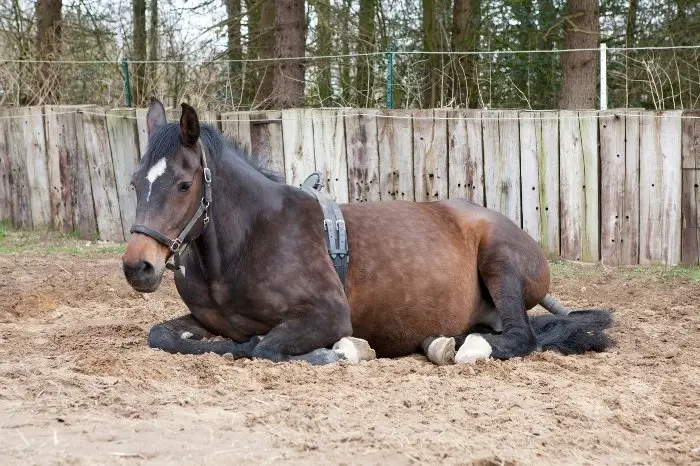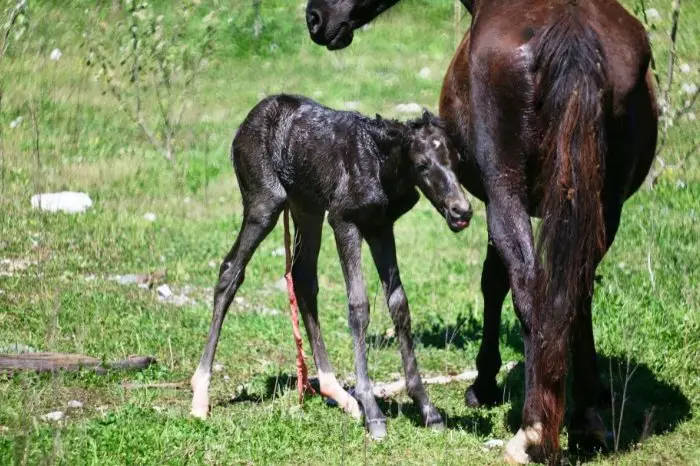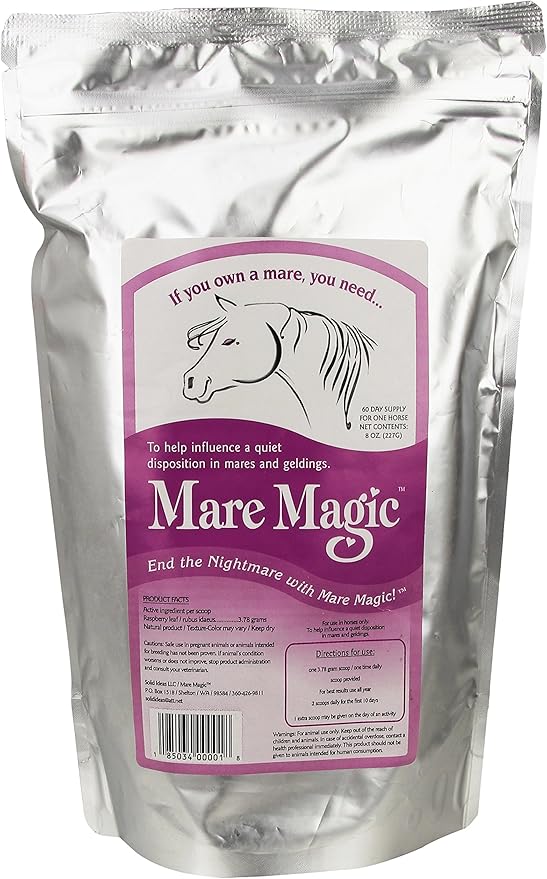Last Updated on January 21, 2022
If you’ve never seen a horse giving birth, you might be wondering how it all happens! A horse birth is a difficult process and a true miracle of nature. But what horse birth facts do you need to know?
If you’re planning on putting your mare in foal, or are just interested in what happens, there is a lot to learn about horses giving birth. When it comes to horses, reproduction isn’t always easy, and they can have a lot of problems! Let’s take a look at all you need to know about horse birth facts.
What Is Horse Reproduction?
Horse reproduction is the process by which a female horse – the mare – becomes pregnant and gives birth to a foal. Her pregnancy will last for around 11 months, anywhere between 330 and 345 days. During this period, the foal will develop from a tiny embryo into a full-size foal.
After this time, the mare will give birth to the foal. This is also called parturition, labor, or foaling. This foaling process takes place over several stages. Each of these stages is very different and lasts for a certain period of time.

Foaling is a very dangerous time for both the mare and the foal. You need to know what signs to look out for in case the mare is having difficulties. This will help you understand when to intervene and get veterinary help.
Step By Step Guide To Horse Reproduction
For successful horse reproduction, several stages must be completed. Here is a complete breakdown of the stages of horse reproduction:
1. Conception
Firstly, the mare must become pregnant! Mares have a fertility cycle that lasts for 21 days, and she is only able to become pregnant for about 5 days during this period. It is vital that mating or insemination occurs at the right time for a successful pregnancy to occur.
An entire male horse, called a stallion, is needed to impregnate a mare. However, there are two ways this can be done. The first method is called natural covering, where the stallion is allowed to mate with the mare for her to become pregnant.
The other method is called artificial insemination, where semen is collected from the stallion. This is then used to inseminate the mare at the precise moment when she is most fertile. Artificial insemination is a popular method, as it allows mare owners to use stallions who may be located some distance from the mare.
Mare Magic Calming Supplements, 8 oz
2. Pregnancy
Because of the long pregnancy, mares will only produce one foal per year. Some mares become pregnant with twins but this can cause big problems, and it is unlikely that the pregnancy will be successful.
During pregnancy, the mare will show very little change for the first six months. It is only towards the end of her pregnancy that her abdomen will start to increase in size. During this time she will need higher amounts of food to keep herself and the growing foal nourished.
3. Birth
Giving birth takes place over three stages. Each stage lasts for a different length of time:
- First stage: 1 to 4 hours – the mare is preparing to give birth
- Second stage: 10 to 30 minutes – the stage during which the foal is born
- Third stage: 3 to 4 hours – the mare is passing the afterbirth
The total time it takes for a horse to give birth lasts between 4 hours and 10 minutes and 8 hours and 30 minutes.
Horses are prey animals and have naturally evolved to do many things, such as sleeping and foaling, standing up. This is so that they can quickly flee from predators. A horse caught lying down is an easy target for a lion or tiger!
Even after many years of domestication, horses have retained these natural behaviors. This means that, when it comes to giving birth, the mare will stay standing for as long as possible. She will lay down only for the actual birth, which is the second stage of labor.
Amazing Horse Breeding Facts!
- The foal’s heartbeat can be detected just 42 days after conception.
- At two months pregnant, the foal embryo is less than 3 inches in diameter.
- The foal’s hooves start to develop during the third month of pregnancy.
- You can tell when a mare is ready to give birth as she will develop full udders, with a waxy secretion around her teats.
- Mares will normally give birth at night and do not like to be observed while they are foaling.
- In the wild, a mare would leave the herd to give birth. This is to hide her foal from potential predators.
- During the last month of pregnancy, the foal moves around a lot! When the birthing process starts, the foal will normally be laid on its back.
Amazing Horse Birth Facts!
- As the mare goes into labor, the foal will rotate around until his front hooves are pointing towards the birth canal.
- The first part of the foal to pass through the birth canal is the front hooves and nose, in a diving position.
- After the foal is born, the umbilical cord stays connected until it is torn naturally. This allows vital blood and nutrients to be passed from mare to foal.
- A newly born foal can stand just 30 minutes after birth. This is when the umbilical cord will be torn.
- The foal’s first drink of the mare’s milk is vital. This first milk contains colostrum, which gives the foal immunity against diseases. It must be consumed within the first 12 hours of a foal’s life.
- When born, a foal’s legs are incredibly long – up to 90% of their total adult length!
- Foals will start to eat grass within two weeks of birth but continue to suckle from their mother for the first six months of life.

Summary
So, today we have learned some amazing horse birth facts! We hope our guide to horse foaling will be helpful to you, and that you have enjoyed our interesting facts about horse reproduction.
Do you have any questions about horse reproduction and foaling? Or maybe you’ve been lucky enough to see real-life foaling? Add a comment below this post and we’ll get back to you!
Find more information about Life Cycle Of A Horse Facts And Figures!

Kate Chalmers is a qualified veterinary nurse who has specialized in horse care for the vast majority of her career. She has been around horses since she was a child, starting out riding ponies and helping out at the local stables before going on to college to study Horse Care & Management. She has backed and trained many horses during her lifetime and competed in various equestrian sports at different levels.
After Kate qualified as a veterinary nurse, she provided nursing care to the patients of a large equine veterinary hospital for many years. She then went on to teach horse care and veterinary nursing at one of the top colleges in the country. This has led to an in-depth knowledge of the care needs of horses and their various medical ailments, as well as a life-long passion for educating horse owners on how to provide the best possible care for their four-legged friends.
Kate Chalmers BSc (Hons) CVN, Dip AVN (Equine) Dip HE CVN EVN VN A1 PGCE

